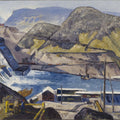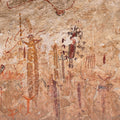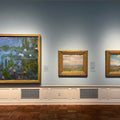Southwestern art as imagined by Chicano and Latinx artists
By Medicine Man Gallery on

Daisy Quezada Ureña, Study no.1, 2016, Porcelain in Sonoran Desert. Courtesy of the artist, © Daisy Quezada Ureña
The same, but different.
“Son de Allá y Son de Acá,” on view at the Chicano Park Museum and Cultural Center in San Diego, unites over 40 Chicano/a/x (Mexican American) and Latino/a/x (Latin American or of Latin American descent) artists living in states along the US-Mexico border, highlighting both similarities and differences. Similarities and differences between their artwork and the Southwestern region they call home.
“Most of the artists are either Mexican American first, second, third generation and beyond, but of course we didn't want to do a show saying we're a monolith (and) all the same,” Rigoberto Luna, exhibition co-curator and co-owner and director at Presa House Gallery in San Antonio, said. “I would compare it to the cuisine of all of these states; while there's similar ingredients to the foods that are being prepared, they're all approached completely different, and they're all presented to us very differently.”
Visit any family owned taqueria in San Antonio or Albuquerque or Tucson or San Diego, order the house specialty, and you’ll experience this for yourself. From place to place, the dishes will feature corn, beans, peppers, beef or pork, and a sauce, but how they’re put together, and the resulting flavors, will be distinct.
So it goes for art as well.
“For us to go to San Diego – there’s different things happening at every crossing – what’s going to be interesting to see is artists from all the different borders who never get to see each other – almost like a border biennial – firsthand stories coming together in one place,” Luna added.
Those firsthand stories center on the U.S.-Mexico border, migration, identity, labor – unseen labor – cultural and family traditions. The same, but different.
The exhibition’s title, “Son de Allá y Son de Acá,” references that duality as well, translating in English to “they’re from here and they’re from there.”
These artists – these people – are from “here” – the Borderlands, the greater Southwest – but they’re from “there” as well, their specific states and communities. The same, but different. Both things.
A borderless geographic region defined by topography and climate, and a highly bordered set of states along one of the most contentious political borders in the world.
That increasing contentiousness, tension, turmoil and violence occurring along the U.S.-Mexico border has come to define the areas. It has given the region a name: the Borderlands. Washington, Montana, North Dakota and Minnesota aren’t broadly referred to as “the Borderlands,” despite being borderlands. That signifier is reserved for America’s southern border.

Southwestern Art
Through a wide range of mediums, artists in “Son de Allá y Son de Acá” reveal the impact of place in shaping their identity and artmaking. Visitors will experience the vibrant artistry found in Arizona, California, New Mexico, and Texas, and feel the pulse of the artists’ communities.
The exhibition further hopes to dismantle assumptions of Southwestern art.
What are those assumptions?
“For me, you think Southwestern art and you think of these grand, amazing landscapes, the mountainous areas and the cowboys on their horses, even in the Western art magazines there’s always paintings of horses and cowboys, the skies in the Southwest,” Luna explains. “(Latinx and Chicano people) have been here and now there's these contemporary works being produced by fourth and fifth generation Latinos that I think in a lot of ways are just finding their voice. Our parents couldn't do this work, weren't encouraged to be full-time artists, they couldn't even speak their own language growing up. Part of it is us rediscovering our histories and then finding a voice in terms of being able to create contemporary work that speaks to all these issues. Western art is going to change because demographics are changing.”
Here’s hoping.
Perhaps evolve is a more precise word.
For Southwestern and Western art writ large to remain relevant, dynamic and vital – as it is today – the genre – from the galleries and museums to the collectors and the magazines – must set inclusivity and expansiveness as priorities and challenge themselves to find and share new stories. New artists. Stories and artists historically left out and welcome them under the tent lest the genre be marginalized as “cowboy” art.
Stories and artists exactly like those featured in “Son de Allá y Son de Acá.”
These are artists born and raised in the West. Their families and cultures helped shape the region. Their artwork examines the most important issues facing the West today. This is Western art as surely as anything being produced by the Cowboy Artists of America.

Mata Ruda, The memory of this moment will haunt me forever, a tropical moon, a sleepy lagoon, and you..., 2023, oil on canvas. Courtesy of the artist, © Mata Ruda
Chicano Park Museum
“Son de Allá y Son de Acá” opened at the Chicano Park Museum and Cultural Center in the Barrio Logan neighborhood of San Diego on October 7, 2023. The exhibition opening coincided with the museum’s first anniversary, the result of years of grassroots organizing to secure the land and funding to build.
Whether for the exhibition or to gaze in amazement at the most significant mural program anywhere in America, make Barrio Logan – a site of activism for over 50 years – a “must see” on your next visit to San Diego.
“It's important to realize Logan Heights was the oldest neighborhood in the city of San Diego, so the history is rich,” Josephine S. Talamantez (Chicana/Yaqui), Chicano Park Museum and Cultural Center Board Chairman, told KPBS in San Diego before the museum’s opening on October 8, 2022. “We were demonized to a certain extent by the entrance of Interstate 5 and the California 75/San Diego Coronado Bay Bridge because it destroyed more than three fourths of our community; we lost at least 15,000 residents through eminent domain and we've been spread throughout the area. Prior to that, due to redlining, we were in many ways segregated to Logan Heights, we were very close. When the disbursement happened, many community members went to the surrounding areas, but have come back because this was home.”
In 1970, the city wanted to force a Highway Patrol station into the neighborhood where community members had been negotiating for a park. Residents rose up in resistance, stopping the project, forcing the city to give them their park – Chicano Park.
Since 2016, Chicano Park has been recognized as a National Historic Landmark.
The Chicano Park Museum and Cultural Center welcomes the public for tours, special events, festivals, and exhibitions. “Son de Allá y Son de Acá” will be on view well into 2024.

Selina A. Scott, I knead my dough the way you showed me, 2023, acrylic on canvas © Selina A. Scott
working in a region with deeply shared histories while uncovering the common threads and examining the similarities of parallel narratives, cultures, and heritage.
This cross-border exchange highlights the shared historical and socio-political ties between states within the American Southwest, predating the Spanish conquest to current complexities at the US-Mexico border.



